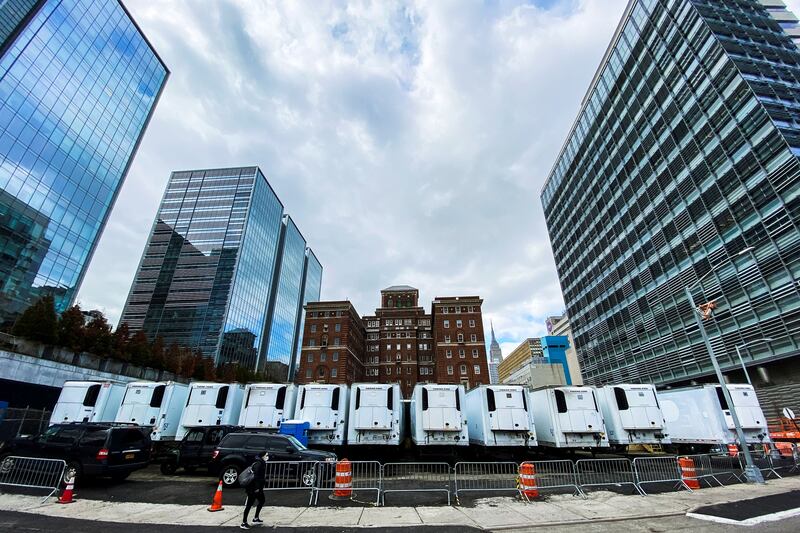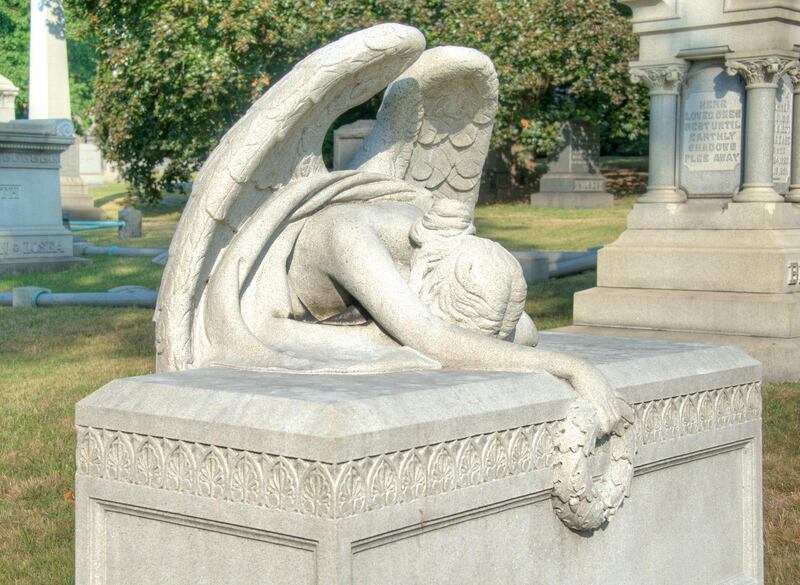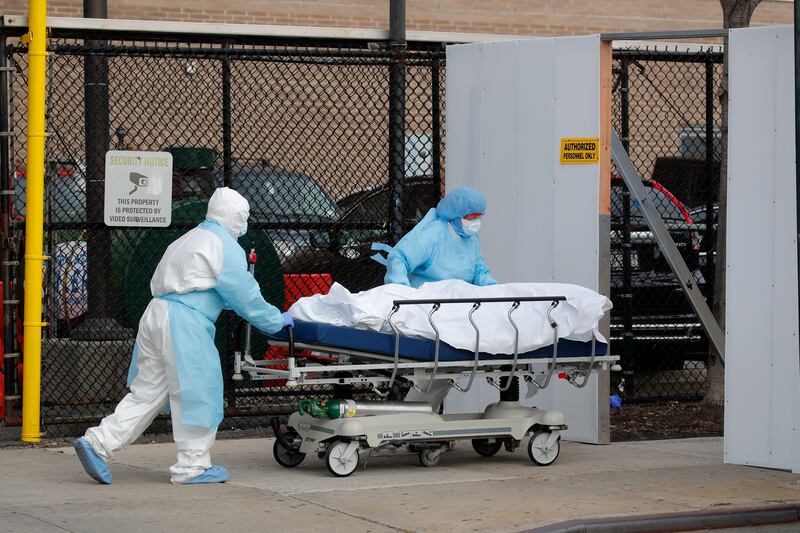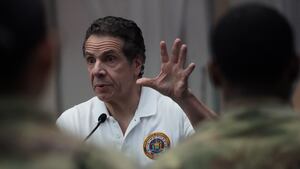Joseph Neufeld has worked at his family’s funeral home in Queens for more than 50 years. He knows the usual flow of activity: a death call once a day, maybe two, from a family home or a neighboring hospital. Collect the body, meet the family, host the funeral—big events, overflowing with friends and family members. Maybe six or seven of those a week.
Last week, there were 25. The events were somber, shorter, with fewer family members. Today, Neufeld decided there will be no more visitations at all. With the way the virus is spreading, he said, it’s simply too much to pull off.
“I’ve been doing this over 50 years,” he told The Daily Beast. “It’s never been like this. I’ve had busy times, but nothing like this.”
Neufeld’s funeral home is located six blocks from Elmhurst Hospital, the epicenter of the COVID-19 crisis in New York City. Last week, 13 people died of the virus at the hospital in a single day. Four more died in the next 24 hours. Doctors at the hospital called the situation “apocalyptic.”
Just as the virus is straining healthcare resources, it is pushing the city’s death-care industry to its limit. Hospitals are calling in mobile morgues to hold extra bodies. Funeral homes are running low on protective gear. Crematories have arranged for “curbside pickup” of human remains. In interviews with funeral home and cemetery directors around the city, workers described an industry on the verge of collapse.
“The death rate is more than the funeral industry can handle,” said Patrick Kearns, of Leo F. Kearns Funeral Home in Queens. “We’re all being completely overwhelmed.”

Refrigerated trailers have been placed outside Bellevue Hospital to serve as makeshift morgues for coronavirus victims.
Eduardo Munoz/ReutersThe problem starts at the hospital. More than 12,000 people are currently hospitalized in New York state; about a quarter of those are in intensive care. Mayor Bill de Blasio has said the city needs to increase its hospital capacity from 20,000 beds to 65,000 beds by the end of April. But that won’t do much for the dead—almost 1,400 of them so far. Some projections estimate the death toll could reach 16,000 in New York state alone.
To handle the increase in bodies, the city has purchased 45 refrigerated trucks to station outside hospitals. FEMA also plans to send another 85 mobile morgues to the area, and the Department of Defense Mortuary Affairs is sending 42 staffers to the city’s chief medical examiner’s office. A spokesperson for the office told The New York Times that the 45 trucks would increase the city’s morgue capacity from 900 to at least 3,500.
But the body count problem trickles down. More bodies in the morgue means more competition for funerals, which means more competition for graves, which means more bodies sitting in the morgue, waiting for someone to pick them up. Avi Schuman, an assistant at a Jewish burial organization in Brooklyn, said he recently spent three hours at the hospital waiting for a funeral director to collect a body.
“This is overwhelming and the funeral homes themselves are not coping, the people picking up the bodies are not coping; the whole system is strained,” Schuman said.
At his funeral home in Queens, Kearns says he hosted more than 60 funerals in the last month. In a typical month, he hosts 40. His staff is working round the clock, with no days off, but they’re still struggling to keep up. “It’s completely overwhelming,” he said.
Lately, Kearns has had to get creative. He souped up the air conditioning in one of his unused chapels last week and cranked it until the temperature reached just over 50 degrees. He’s using it as storage space for overflow bodies.
Several funeral home directors said they’re feeling pressure from the city not to hold visitations, or to keep them short. Most viewings are restricted to immediate family and are supposed to be capped at 20 minutes. At least one Jewish funeral home is now doing only graveside funerals. Neufeld said some families have dispensed with the visitations entirely, moving straight to burial or cremation.
But Kearns said visitations are even more important for families of COVID-19 victims.
"Often they're going off in an ambulance and the family never sees them again,” he said. “These people are dying alone because they can’t have visitors... The thought of just taking them from the hospital and immediately cremating them, which some people have suggested should be done, is really difficult on the family.”
Neufeld said he hasn’t been militant about the number of people at visitations either. “If more come in the door, we’re not turning them away,” he said. “We're not telling them they can’t come in. I just don’t agree with that.”
The biggest problem for funeral directors comes after the visitation. Arranging for a burial or interment—a process that usually takes hours—now goes on for days. Overwhelmed cemeteries and crematoriums have week-long waiting lists. Some are running with half crews, splitting their employees into two groups so that one can keep working even if the other gets sick. Graveyards run by the Department Veteran’s Affairs—including Calverton National Cemetery on Long Island—have canceled all committal services until further notice.
Kearns said he feels like some cemeteries are not doing enough. “I was sounding the alarm early about [how] we need to work with the cemeteries and crematories so they can increase the numbers,” he said.
“There are plenty of nurses and doctors who are working longer days than they normally work,” he added. “Funeral directors are stepping up, and the cemeteries need to step up and increase their hours. We all have to work harder just to keep up with this.”

The crematory chambers at historic Green-Wood Cemetery are working double shifts.
Bestbudbrian/Wikimedia CommonsFrom his office at Green-Wood Cemetery in Brooklyn last week, Rich Moylan watched a funeral progress as if on a foreign planet. The families waited in their cars while the gravediggers, clad in full-body hazmat suits, rested the casket on the lowering deck. The gravediggers moved 10 feet away and allowed a few family members, all in surgical masks, to approach the grave and say their goodbyes. Others stayed in their cars and waved through the windows. When the family retreated to a safe distance, the gravediggers returned and lowered him into the grave.
“It was pretty darn sad,” said Moylan, who has worked at Green-Wood for nearly 50 years. “I’m getting choked up just thinking about when I looked out my window and saw that.”
But what worries Moylan most isn’t the burials, it’s the cremations. Green-Wood has the most crematory chambers in the city, and right now they’re working double shifts—6 a.m. to 9 p.m., thanks to orders from the city letting them expand their hours. (Hours after Moylan’s interview, the NYC Department of Environmental Protection announced that crematoriums could extend their operations to 24 hours a day, seven days a week.)
Moylan said he trained more people in using the crematorium last year than he ever thought necessary, and he's glad he did. Demand for cremations has gone up 50 percent in the last week alone. Funeral homes he’s never seen before are showing up, asking for their services. The city medical examiner’s office even asked Green-Wood to help out the other day. Moylan said he had to turn them down because he was over capacity.
As concerned as he is for volume, Moylan is also worried about the health of his staff. Other crematories have switched to “curbside pick-up:” no mourners in or out of the office, leave the remains in your car, someone will come collect them. Moylan said Green-Wood isn’t there yet. But it’s stopped all nonessential services, like tree trimming and memorial maintenance, and is focusing on what he calls the “sacred duty:” burying the dead.
At age 65, Moylan is in a high-risk category but is still coming into the office every day. “I can’t stay home if I’m asking my people to be here and risk themselves,” he said.
Everyone in the death industry is worried about their workers these days. According to the New York Department of Health, there is no known risk associated with being in the same room as someone who died from the virus. But close family members—the kind who attend funerals and visitations—may have already been exposed. (The U.S. Occupational Safety and Health Administration classifies funeral home workers who engage with these family members as a “high exposure risk.”)
And death-care workers aren’t immune to the protective equipment shortages plaguing the rest of the country. At Cobble Hill Chapels, funeral director Brooklyn Pesola said she orders her masks and gloves from the same supplier as local hospitals, which is struggling to meet demand. She doesn’t know what will happen when the virus reaches its peak, which isn’t expected for weeks.
"Once we’re down to the last glove and the last mask we’re pretty much done, I guess,” she said.

But what’s hardest for many of the directors is watching families try to grieve in this environment. For all their solemnity, funerals are usually touchy-feely things: lots of hugging, kissing, wiping of each other’s tears. Now even family members are being asked to stand 6 feet apart as they mourn.
“Normally you have a full day of visitation, even two, and you have friends and other family members that can come,” said Neufeld’s son, Joseph Jr. “Being able to speak with them can take your mind off of the death of your loved one. And now they’re being denied that.”
Kearns said it’s even affecting his own work as a funeral director. He’s worked in the community for 25 years, and some of the people who come in are like family to him. “Finding ourselves sitting 6 feet across the table from someone with a mask on, It's not what we do,” he said. “It’s not how we do it.”
Like many New Yorkers, Moylan said the feeling reminded him of 9/11—only, somehow more unsettling. “With 9/11, the goal was to get back to normal,” he said. “Now it’s like, ‘No, we can’t get back to normal.’ We don’t know when we’re going to get back to normal.”
On that day in 2001, Moylan was at a cemetery convention in Canada. He watched the towers fall on TV in disbelief, unable to reach his wife of his coworkers.
“That was the worst day of my life,” he said. “And I’m wondering if this is ultimately going to be worse.”


